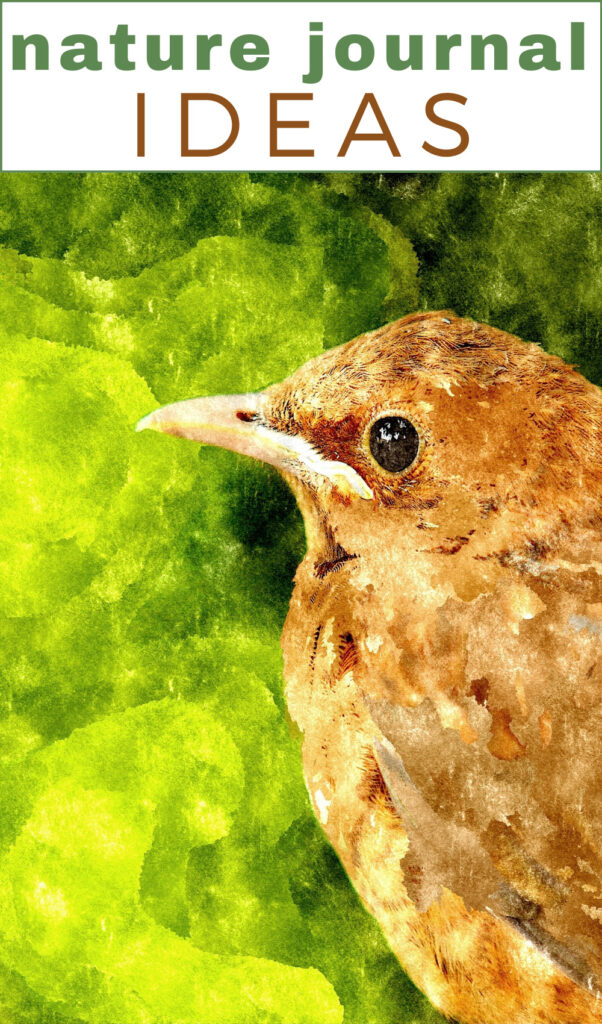There are so many benefits to nature journaling that it’s become a very popular way to express creativity and tap into mindfulness for most these days. The next time you head outside for a hike or a local walk, consider this artistic expression option and see where your journey takes you.
How do you start nature journaling? Dedicate time for a nature walk and bring along your favorite mediums – paper, pencils, markers, chalks. Then, find a spot to rest and begin to document what you see freely and without borders. Write notes, draw creatures, begin creative prompts, and capture the essence of the day.
Nature art journaling allows you to practice mindfulness, connect with your body and senses, see a side of nature you’ve never noticed before, and truly forces you to slow down. How often throughout your life do you allow yourself to enjoy small moments like this? Quiet ones? It’s easy when you surround yourself with nature.
What is Nature Journaling?
Nature journaling is the simple act of recording what you see and how you feel as you walk through a park, hike, sit on a beach, or watch the sunset. Imagine any scenario that you can think of where you truly connect with nature in a meaningful and quiet way and then allow yourself time to document your feelings about that moment.
As you record these moments, it will allow you to plug into all of your five senses. Journaling helps people take notice of what’s happening all around them and allows them to acknowledge their immediate reactions.
Every journal entry becomes a souvenir of a moment in time. Something that can be revisited time and time again. An art journey!
Nature Journaling Supply Kit
If you’ve ever kept a diary, you know perfectly well that journaling doesn’t require much – just a notebook, pencil, and eraser. However, as you progress through your journey, you might want to create a little toolkit that will enable you to detail your drawings and bring a new layer of life to your expressions. Here’s a supply kit list to reference should you ever want to expand your sketches:
- brushes
- binoculars
- a bug box with magnifying lid
- tweezers
- chalk
- paint
- watercolor paint
- clay
- crayons
- textiles
- crayon pencils
- markers or black sharpies
- blanket for sitting
Nature Art Journal Ideas
One of the beautiful things about a nature journal is that it’s completely yours and it’s up to you to decide what to do with it. It allows you to express yourself in a way that feels right to you. So, your journal entries can be as abstract or as concrete as you want. Let’s break down what this means.
If you are a meticulous fact-lover/analytical thinker, consider making lists of things you see during your outing – like all birds and insects.
- trees
- fungus
- flowers
- clouds
- birds
- insects
- colors
- rocks
- shapes
- smells
If you are someone who has trouble recognizing plants and animals, there are plenty of apps to help you with that – iNaturalist, PictureThis, etc.
But if facts and lists don’t work for you, that’s ok. Instead, fill the pages of your journal with colorful leaf rubbing art or drawings of your own. You could also research famous quotes that represent what you see to add an additional dimension.
Do you write poetry on your own? Awesome! How about creating a special poem to help capture your emotions from the day? Create whatever story you’d like. It’s all about art, joy, and peace.
How to Keep A Nature Journal
As you can see, a nature study journal doesn’t require many tools, and you don’t need to be an accomplished writer or painter to do it. In fact, not stressing about things is kind of the point.
You’ll find keeping a journal is easy, hassle-free, and pleasurable. Here are a few tips you can use before you start:
- Make this a habit – A diary with a single entry can hardly be called a diary. You don’t have to do it every day. Just make sure you make a habit out of it and be consistent.
- Use all five senses – Use your sight, hearing, smell, touch, and occasionally taste (when it’s safe and appropriate) to get a complete picture of anything that catches your attention. Regarding taste, you could potentially bring fruit along with you. It isn’t advisable to taste wild berries you are unfamiliar with.
- There are no wrong answers – Remember, nothing you put in your journal would ever be considered wrong. Act freely as you interpret nature.
- Collect nature items and add them to your journal – Tree leaves, feathers, wildflowers, and other things you find will make this activity more colorful and unique.
- Nature is everywhere – You don’t need to travel far to take on this hobby! A few blocks will do…or even your backyard. A big misconception is that you need to go hiking to connect with nature and that isn’t the case.
- Include yourself – If you decide to draw your entire setting, don’t forget to mark where you sat during the day. Consider placing an X or some other symbol so you remember.
Thought Starters
At the start (or somewhere in the middle) of your journaling journey, you might experience blank page anxiety or a creative block. While these two conditions aren’t the same, the result of suffering from either is a full pause! Please consider these journaling thought starters to help jump-start your creativity:
- What did the tree feel like when you touched it?
- How did the wind feel?
- Was the sun strong that day?
- What type of animals did you come across?
- What signs of the season did you notice?
- What did you feel at the moment?
- What prompted the walk?
- Imagine the beginning of a story that started from where you sat to make an entry in your journal. What would it sound like?
- Picture a fantastical creature coming out from behind the tree nearest to you – what does it look like?
- If you shrank and had to live where you sat for a day, what would you find?
- What lives under you?
- What emotions do you feel when you are alone in nature?
- How was the day before arriving at this spot? How does it feel right now?
- If you could turn into any animal, what would it be?
Journaling A Year In Nature
Nature looks and feels different every season. So, it is only natural that documenting it throughout the year will change. That is why keeping up with this hobby for at least 365 days will really reap big rewards. Here are some things you can expect per season.
Winter
- White snow
- Red cranberries
- Snowmen
- Children playing
- Empty trees
- Snow tracks
Spring
- Flowers Blooming
- Bugs
- Pollen – potential sneezing
- New life
- Rain
Summer
- Water – beach, pond, lake life
- Hot days
- Track new birds you see
Fall
- Crunchy leaves
- Leaf color changing
- Acorns
- Different weather patterns
Nature is so different and so beautiful in every season. Now that you’re finally listening and observing, you will appreciate every moment.
Nature Journaling For Kids
For kids, every outing is an exciting adventure. Kids will love to take part in this activity and you will see that your entire family will look forward to family walks even MORE now that art is involved.
Allow them to record everything they see, touch, and smell. Give them full freedom! This will be a diary they will never want to throw away.
Nature journaling for kids will boost their creativity and allow you to see the world through their eyes. A family bonding experience that you will never forget.
- 6 Tips to Starting & Keeping A Gratitude Journal All Year
- 30 Inspirational Art Journal Prompts To Boost Creativity
- How To Use A Sun Gratitude Journal And Why It’s Worth 5 Minutes A Day
- Nature Drawing For Kids – 10 Easy Tutorials To Get Them Started
- Observational Drawing For Kids – 50 Ideas To Get You Started
- 65 Hobbies For Kids That Are Fun, Creative, And Filled With Passion – Free Printable
- 10 Ways To Set Up Special Time With Your Child
- How to Start Journaling for Beginners
- Eco Stars


